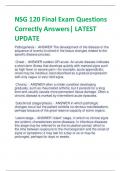NSG 120 Final Exam Questions Correctly Answers| LATEST UPDATE Pathogenesis - ANSWER The development of the disease or the sequence of events involved in the tissue changes re lated to the specific disease process. Onset - ANSWER sudden OR acute - An acute disease indicates a short -term illness that develops quickly with marked signs such as high fever or severe pain —for example, acute appendicitis; onset may be insidious, bes t described as a gradual progression with only vague or very mild signs. Chronic - ANSWER often a milder condition developing gradually, such as rheumatoid arthritis, but it persists for a long time and usually causes more permanent tissue damage. Often a chronic disease is marked by intermittent acute episodes. Subclinical (stage/phase) - ANSWER in which pathologic changes occur but the patient exhibits no obvious manifestations, perhaps because of the great reserve capacity of some organs. Latent stage - ANSWER "silent" stage, in which no clinical signs are evident, characterizes some diseases. In infectious diseases this stage may be referred to as the incubation period, which is the time between exposure to the microorganism and the onset of signs or symptoms; it may last for a day or so or may be prolonged, perhaps for days or weeks. Disease transmission of an insect bite - ANSWER The injury occurs when the insect either bites or stings the patient. Venom is injected into the tissue, resulting in the body's response to a foreign protein. Rocky Mountain Spotted Fever/Tick Bite disease transmission - ANSWER The causative age nt, Rickettsia rickettsii, is transmitted by the wood tick and is carried in the feces of infected ticks. It is introduced into the bloodstream of a person during a prolonged tick bite. Symptoms of Rocky Mountain Spotted Fever - ANSWER Class triad: head ache, fever, maculopapular rash (bumps and petechial rash) high fever Malaria/Mosquito bite disease transmission - ANSWER Malaria is caused by four species of the protozoan genus Plasmodium, which is transmitted from infected human to human by the bite of mosquito vectors or, less commonly, by blood transfusion or IV drug use. Disease transmission of animal/human bites - ANSWER The bite occurs when the offending animal is agitated, frightened, threatened, or angry. Bites can be from domestic animals, such as cats and dogs; farm animals; or wild animals, such as skunks, bats, raccoons, and foxes. Human bites have been recorded. The pattern of the teeth marks is helpful in determining the type of bite, human or animal, and the type of animal that did th e biting if not immediately known. Snake bite disease transmission - ANSWER Four kinds of poisonous snakes are known to inhabit the United States: rattlesnakes, copperheads, water moccasins, and coral snakes. Some bites are the work of nonpoisonous sna kes, but all snakebites should be treated as poisonous by the first aid provider. Cardinal Signs of Inflammation - ANSWER The cardinal signs of inflammation are redness (rubor or erythema), heat, swelling, and pain; sometimes loss of function Diangost ic blood changes that may indicate inflammation? - ANSWER *Leukocytosis (increased WBC) *Differential count of WBC *plasma protein (increased prothrombin and fibrinogen) *CRP (appears with acute inflammation and necrosis) *increased ESR *cell enzymes pres ent (may indicate necrosis) Treatment of inflammation - ANSWER *Drugs - Aspirin, NSAIDS, etc. *RICE (rest, ice, compression, elevation) *Compression stockings *Moderate exercise Opportunistic infection - ANSWER Microbes that are not usually pathogenic but can become pathogenic when transferred into another location of the body, if the balance of the species is not maintained, or if the body's defense is impaired. Stages of Pressure Ulcers - ANSWER Stage I: Intact skin with non-blanchable redness of a localized area usually over a bony prominence. Darkly pigmented skin may not have visible blanching; its color may differ from the surrounding area. Stage II: Partial thickness loss of dermis presenting as a shallow open ulcer with a red pink wound bed, without slough. May also present as an intact or open/ ruptured serum -filled blister. Stage III: Full thickness tissue loss. Subcutaneous fat may be visible but bone, tendon or muscle are not exposed. Slough may be present but does not obscure the depth of tissue loss. May include undermining and tunneling. Stage IV: Full thickness tissue loss with exposed bone, tendon or muscle. Slough or eschar may be present on some parts of the wound bed. Often include u ndermining and tunneling. Deep Tissue Injury Purple or maroon localized area of discolored intact skin or blood -filled blister due to damage of underlying soft tissue from pressure and/or shear. The area may be preceded by tissue that is painful, firm, mus hy, boggy, warmer or cooler as compared to adjacent tissue. Unstageable: Full thickness tissue loss in which the base of the ulcer is covered by slough (yellow, tan, gray, green or brown) and/or eschar (tan, brown or black) in wound bed Glaucoma signs & symptoms (narrow and open angle) - ANSWER One of the major causes of blindness. Can occur at any age but most common in those over 60. Narrow angle Glaucoma: occurs when the angle between the cornea and the iris in the anterior chamber is decreased by factors such as an abnormal anterior insertion of the iris. With aging, the lens enlarges, pushing the iris more forward and to the side. Increase in intraocular pressureBlocks aqueous fluid. Chronic Glaucoma (wide angle): Most common form of glaucoma in 1-2% of population. Trabecular network becomes obstructed. Damage is irreversible and causes blindness




